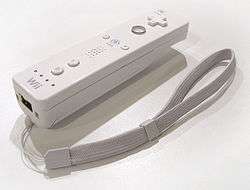Motion controller
A motion controller controls the motion of some object. Frequently motion controllers are implemented using digital computers, but motion controllers can also be implemented with only analog components as well.
Implementation
Motion controllers require a load (something to be moved), a prime mover (something to cause the load to move), some sensors (to be able to sense the motion and monitor the prime mover), and a controller to provide the intelligence to cause the prime mover to move the load as desired.
Just about everything that is man-made requires motion control during its manufacture, packaging, distribution or use.
Benefits
Motion controllers are used to achieve some desired benefit(s) which can include:
- increased position and speed accuracy
- higher speeds
- faster reaction time
- increased production
- smoother movements
- reduction in costs
- integration with other automation
- integration with other processes
- ability to convert desired specifications into motion required to produce a product
- increased information and ability diagnose and troubleshoot
- increased consistency
- improved efficiency
- elimination of hazards to humans or animals
The history of true video motion control without a joystick goes back to 1987 where an experimental photographer Vincenzo Giovanni Ruello has released archive footage showing him moving his hand in front of a specially designed video graphic and causing the centre of the graphic to move and change without disturbance to the outer graphic a system later perfected in the 21st century with such systems as Wii and others.
Gaming

Motion controllers using accelerometers are used as controllers for video games, which was publicly introduced in 1981 by Datasoft's "Le Stick" controller for the Atari 2600, and made more popular since 2006 by the Wii Remote controller for Nintendo's Wii console, which uses accelerometers to detect its approximate orientation and acceleration, and serves an image sensor,[1] so it can be used as a pointing device. It was followed by other similar devices, including the ASUS Eee Stick, Sony PlayStation Move (which also uses magnetometers to track the Earth's magnetic field and computer vision via the PlayStation Eye to aid in position tracking), and HP Swing.[2] Other systems use different mechanisms for input, such as Microsoft's Kinect, which combines infrared structured light and computer vision, and the Razer Hydra, which uses a magnetic field to determine position and orientation.
The Sega AM2 arcade game Hang-On, designed by Yu Suzuki, was controlled using a video game arcade cabinet resembling a motorbike, which the player moved with their body. This began the "Taikan" trend, the use of motion-controlled hydraulic arcade cabinets in many arcade games of the late 1980s, two decades before motion controls became popular on video game consoles.[3] The Sega Activator, based on the Light Harp invented by Assaf Gurner, An Israeli musician and Kung Fu martial artist who researched inter disciplinarian concepts to create the experience of playing an instrument using the whole body's motion. [4] was released for the Mega Drive (Genesis) in 1993. It could read the player's physical movements and was the first controller to allow full-body motion sensing, The original invention related to a 3 octaves musical instrument that could interpret the user's gestures into musical notes via MIDI protocol. The invention was registered as patent initially in Israel on May 11 1988 after 4 years of R&D. In 1992 the first complete Light Harp was created by Assaf Gurner and Oded Zur and was presented to Sega of America, However, it was a commercial failure due to its "unwieldiness and inaccuracy".[5] Another early motion-sensing device was the Sega VR headset, first announced in 1991. It featured built-in sensors that tracked the player's movement and head position, but was never officially released.[6] Another early example is the 2000 light gun shooter arcade game Police 911, which used motion sensing technology to detect the player's movements, which are reflected by the player character within the game.[7] The Atari Mindlink was an early proposed motion controller for the Atari 2600, which measured the movement of the user's eyebrows with a fitted headband.
References
- ↑ Castaneda, Karl (2006-05-13). "Nintendo and PixArt Team Up". Nintendo World Report. Retrieved 2007-02-24.
- ↑ "HP ships Swing motion controller hardware with Pavilion PCs in India". Engadget. Retrieved 2011-11-01.
- ↑ http://web.archive.org/web/20131113173854/http://www.1up.com/features/disappearance-suzuki-part-1?pager.offset=1
- ↑ Light Harp at CES 1993. YouTube. Retrieved 2010-07-06.
- ↑ Horowitz, Ken (2004-08-03). "Top 10 Tuesday: Worst Game Controllers". Sega-16. Archived from the original on 2010-02-06. Retrieved 2010-12-04. External link in
|work=(help) - ↑ Lanxon, Nate (11 March 2008). "Sega VR". Vapourware: The tech that never was. CNET.com. Retrieved 15 May 2012.
- ↑ Police 911 at the Killer List of Videogames